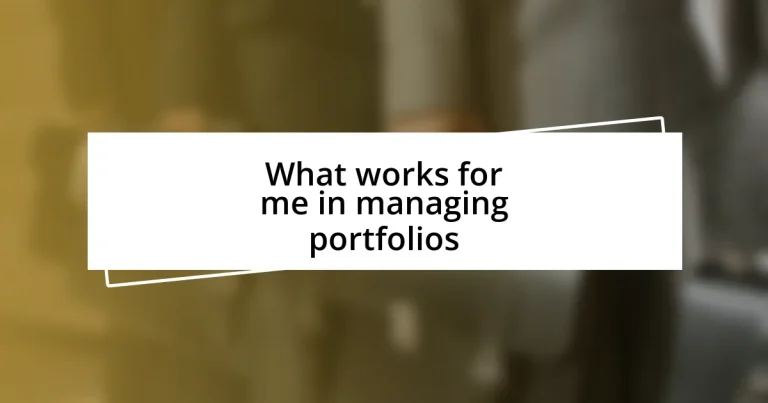Key takeaways:
- Diversification and regular portfolio rebalancing are crucial for mitigating risks and adapting to market changes smoothly.
- Setting clear investment goals based on time horizon and risk tolerance simplifies decision-making and enhances focus on financial objectives.
- Utilizing tools like portfolio tracking software and investment research platforms, alongside engaging with community forums, improves investment strategies and outcomes.
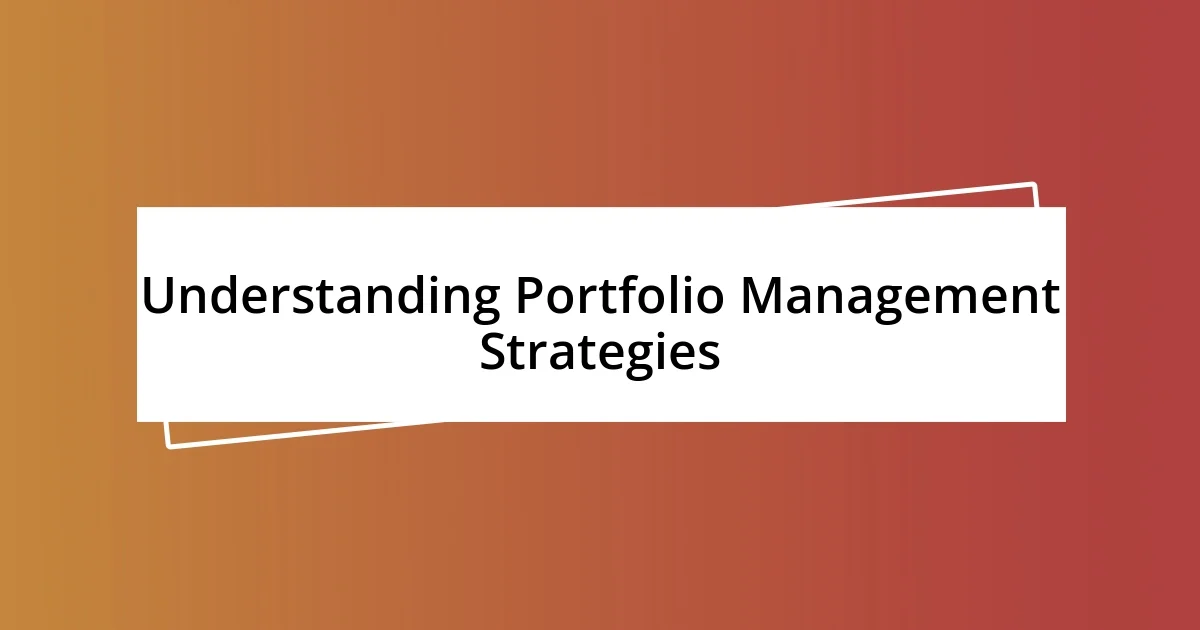
Understanding Portfolio Management Strategies
Understanding different portfolio management strategies is crucial for achieving financial goals. I remember when I first delved into diversification—it felt like a revelation. The idea that spreading investments could lower risk and enhance potential returns was a game changer for me. Have you ever thought about how a well-diversified portfolio might protect you during market downturns?
Another strategy I’ve found valuable is active versus passive management. Initially, I leaned toward active management, getting swept up in the thrill of seeking out undervalued stocks. But over time, I recognized that passive management often leads to lower fees and consistent growth—like riding a steady wave instead of chasing every sudden swell. Have you considered how aligning your strategy with your comfort level and risk tolerance can produce better results?
Finally, I can’t emphasize enough the importance of rebalancing your portfolio regularly. I recall a period when I neglected this task; my portfolio drifted too heavily into one sector. It was a wake-up call when I realized the impact of such oversight. Are you checking in on your investments often enough to ensure they align with your changing goals and market conditions? Each of these strategies has taught me something valuable, reinforcing that portfolio management is as much an art as it is a science.
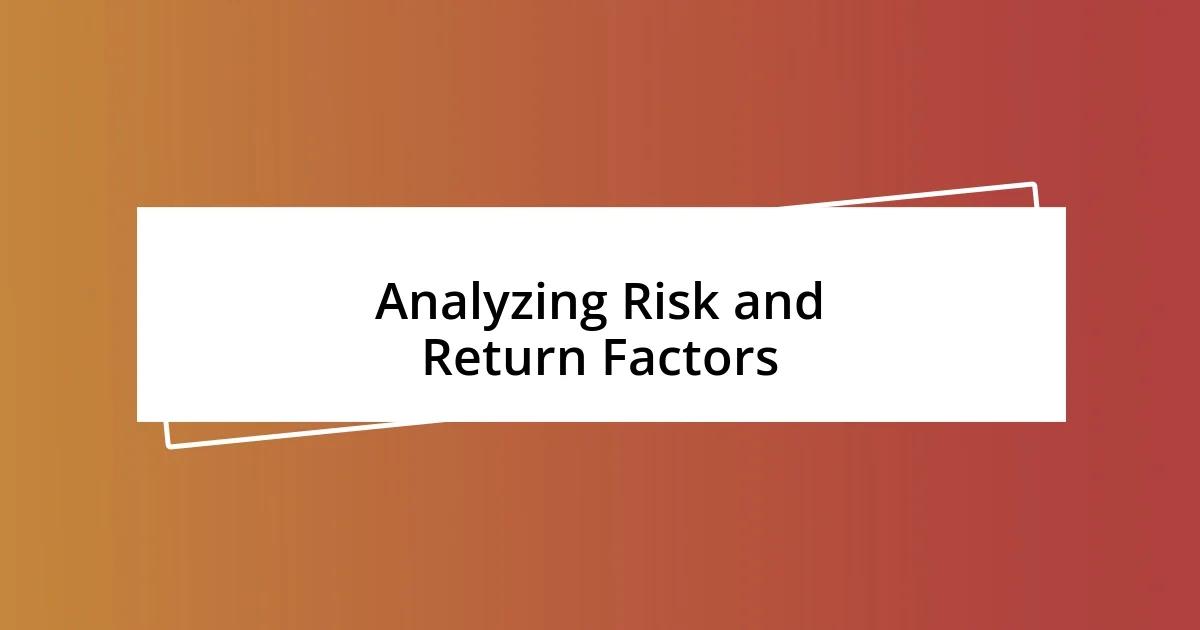
Analyzing Risk and Return Factors
Analyzing risk and return factors is an essential part of portfolio management that I’ve come to appreciate over the years. I remember my early days of investing when I overlooked the correlation between risk and return, focusing solely on chasing returns. It was a bit like sprinting to the finish line without considering the hurdles in my path. Understanding these factors helped me create a more balanced approach, allowing my investments to flourish while minimizing the impact of market volatility.
One critical component I’ve learned to analyze is the volatility of my investments. In my experience, assessing a stock’s historical price fluctuations can reveal a lot about its potential future behavior. For instance, I once invested heavily in what seemed like a promising tech stock, only to watch it plummet due to unexpected market shifts. This incident reinforced the lesson that higher returns often come with higher risks, and I started to carefully weigh my options before diving into high-volatility investments.
Lastly, the interaction between asset classes has become a focal point in my risk-return analysis. I often find myself reflecting on how various assets respond differently to market conditions. For example, during a recent economic downturn, I was pleasantly surprised at how my bond investments provided stability, cushioning the volatility from my equities. This dynamic interplay between different assets has taught me that a well-rounded portfolio is vital for maintaining peace of mind, especially during uncertain times.
| Factor | Explanation |
|---|---|
| Risk | The potential for loss or the variability of returns on an investment. |
| Return | The gain or loss made on an investment relative to the amount invested. |
| Volatility | A measure of the price fluctuations of an asset over time. |
| Correlation | The relationship between the movements of two assets in response to market changes. |

Setting Clear Investment Goals
Setting clear investment goals has been a game changer in my journey as an investor. I recall feeling overwhelmed by the sheer number of options when I first dipped my toes into the market. It hit me that without specific goals, I was essentially wandering in a maze without an exit. Defining what I wanted—be it saving for a home, retirement, or building an emergency fund—provided me with a clear path and purpose.
Here are some things I consider when setting my investment goals:
- Time Horizon: Determine whether your goal is short-term, medium-term, or long-term. This affects your investment choices.
- Risk Tolerance: Honestly assess how much risk you’re willing to take. Are you comfortable with potential losses?
- Financial Milestones: Break down larger goals into smaller, actionable targets to keep you motivated and focused.
- Regular Review: I find it helpful to revisit my goals periodically, adjusting them as life circumstances change.
The clarity that comes with setting these goals makes decision-making much easier. For instance, when I set a goal to save for a vacation, I allocated a portion of my portfolio specifically for lower-risk investments. This not only calmed my anxiety about the market but also gave me a thrilling sense of anticipation as I watched that fund grow. Knowing why I invest fuels my passion and commitment, turning what can often feel like a daunting task into an exciting adventure.

Diversifying Your Portfolio Effectively
Creating a diversified portfolio is not just about throwing money into different investments—it’s about strategic allocation that aligns with your risk tolerance and financial goals. I’ve learned that diversification can mean different things to different people. For instance, I once split my investments among stocks, bonds, and real estate, only to realize later that they were all correlated and reacted similarly to market changes. That experience taught me the importance of looking beyond just the asset classes and considering how they interrelate.
As I continued my investment journey, I began to explore less traditional avenues, such as international markets and peer-to-peer lending, which not only diversified my portfolio but also made it more resilient. I often ask myself, “What niches can I tap into that others might overlook?” This curiosity led me to invest a small portion of my portfolio into emerging markets. While it came with its own risks, those investments have offered me unique growth opportunities that differ significantly from my U.S. holdings.
Ultimately, effective diversification is an art and a science that demands continuous learning and adjustment. I make it a point to review my portfolio regularly, assessing whether the assets still serve a purpose in reaching my goals. It’s a bit like tending a garden; nurturing the thriving plants while pruning back those that no longer fit the landscape. This ongoing process has provided me not only with financial growth but also with a deeper understanding of my own preferences and fears—an insight that money alone can’t buy.
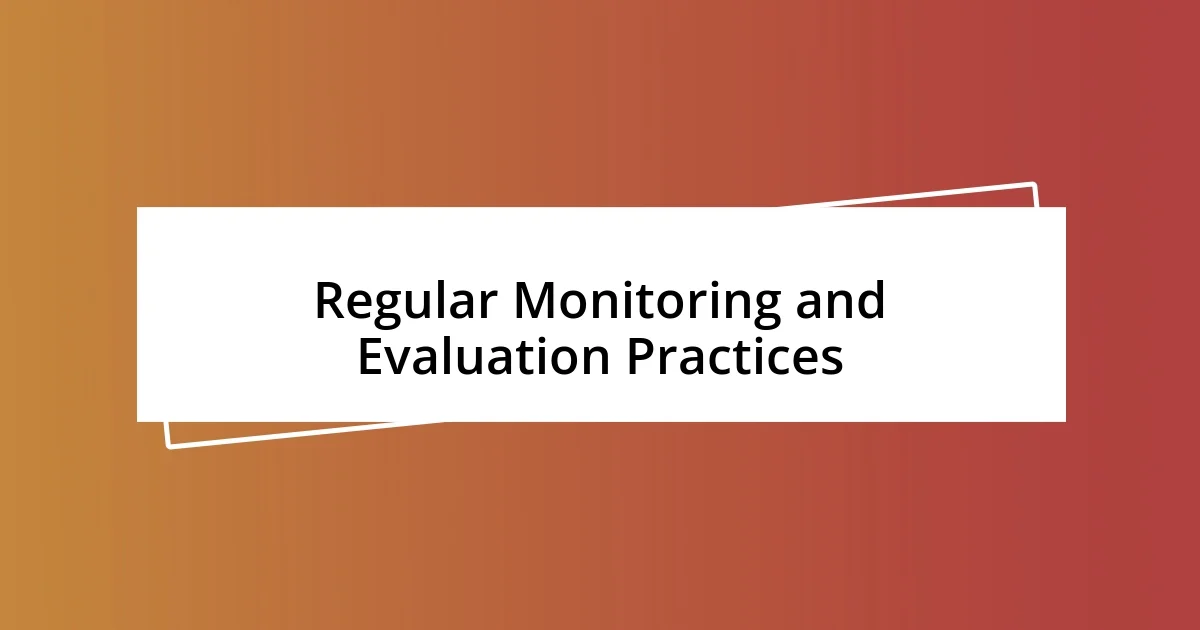
Regular Monitoring and Evaluation Practices
Keeping a close eye on my investments has proven essential in managing my portfolio effectively. I remember a time when I neglected to monitor a particular stock, thinking it would thrive on its own. A sudden market shift caught me off guard, and I lost a significant amount. This taught me that regular monitoring is not just about tallying gains; it’s about understanding when to pivot or double down.
Every month, I schedule dedicated time to review my portfolio’s performance. I often find myself asking, “What are the trends telling me?” It’s during these sessions that I can evaluate which assets align with my goals and which ones need adjusting. Sometimes, I even set alerts for certain stocks, so I’m immediately notified of significant changes. It’s about being proactive rather than reactive, and this approach has not only safeguarded my investments but also instilled a sense of empowerment and control in my financial journey.
Evaluating my portfolio goes beyond numbers; it connects deeply with my financial story. I recall feeling a rush of relief when I discovered an underperforming asset that I could cut. Letting go felt liberating—almost like decluttering my home. This practice has transformed my relationship with investment, shifting it from mere transactions to an active dialogue between myself and my financial aspirations. Regular monitoring is less of a chore and more of a strategic conversation, steering me toward my ultimate goals.
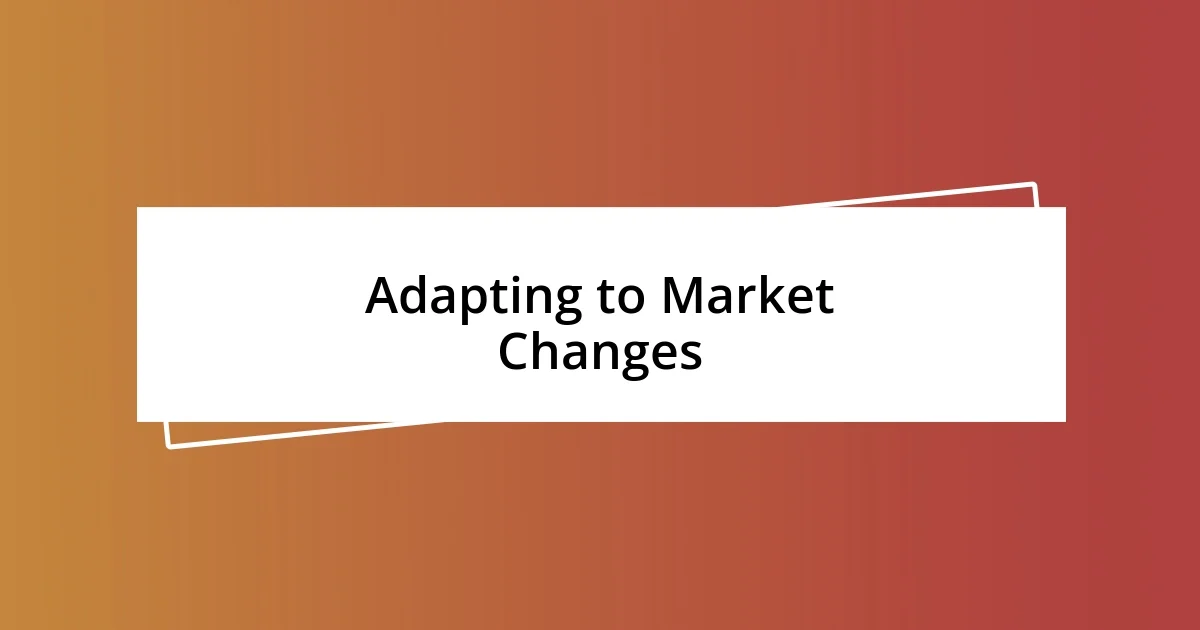
Adapting to Market Changes
Adapting to market changes has become second nature for me over the years, largely because the investment landscape is never static. A while back, I found myself holding onto a tech stock that had a sudden, sharp decline. Instead of panicking, I asked myself, “What can I learn from this?” I quickly reviewed the broader market trends and realized it wasn’t just my stock—entire sectors were experiencing shifts. This insight prompted me to adjust my strategy, shifting funds toward more stable industries like consumer goods, highlighting the importance of being adaptable.
I also remember a period when inflation concerns sent ripples through the market. Instead of clinging to outdated notions about bonds and equities, I began exploring commodities. I dug deeper into gold and silver, thinking about their historical resilience. It was fascinating to see how certain assets can serve as a shield against economic turbulence, reinforcing the idea that adaptability is key in securing not just profits but also peace of mind.
Sometimes, I’ve had to remind myself that change can be uncomfortable but also necessary. During a volatile market phase, I questioned if I should stay the course or make drastic adjustments. This contemplation led me to study market psychology and investor behavior, which revealed that fear often drives impulsive decisions. Embracing change became less about survival and more about growth, allowing me to navigate the waves with a sense of clarity and purpose. How do you respond when faced with unexpected market changes?
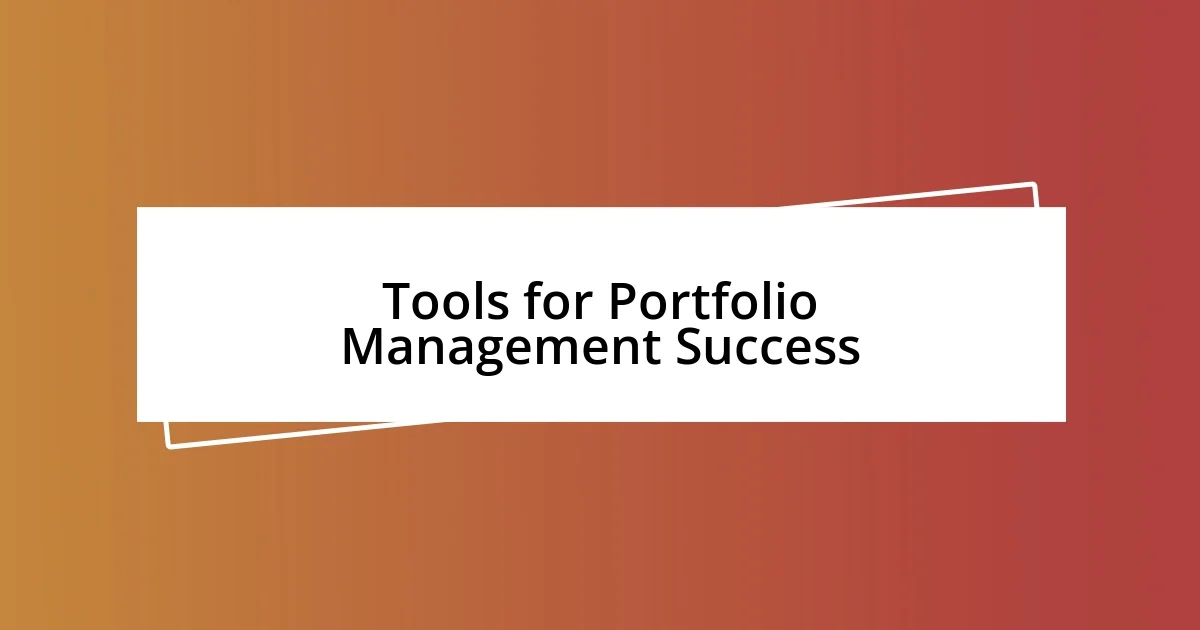
Tools for Portfolio Management Success
Tools play a crucial role in my portfolio management success, shaping the way I make informed decisions. One of the most beneficial tools I’ve discovered is portfolio tracking software. When I first started using it, I was amazed by how easy it made tracking my returns and comparing my performance against market benchmarks. I remember a day when I received a notification about a dip in one of my holdings—I was able to act quickly because I had real-time data at my fingertips. Isn’t it fascinating how technology can empower us to be savvier investors?
Another invaluable tool I rely on is investment research platforms. I often find myself diving deep into reports and analytics before making a move. One time, I came across a detailed analysis of an emerging market that piqued my interest. Instead of blindly investing based on trends, I was able to understand the underlying economic factors at play. It transformed my approach, allowing me to build a portfolio that resonates with my risk tolerance and growth aspirations. Have you considered how research might elevate your investment strategies?
Lastly, I can’t overlook the importance of community forums and social investing platforms. Engaging with fellow investors has opened my eyes to diverse perspectives and strategies. I distinctly remember a conversation where someone shared their experience with index funds, which led me to incorporate them in my own portfolio. It’s a game-changer to learn from others’ wins and mistakes—often sparking insights I wouldn’t have thought of alone. These connections remind me that investing isn’t just about numbers; it’s about shared experiences and collective growth. What tools have you found most beneficial in your investment journey?












